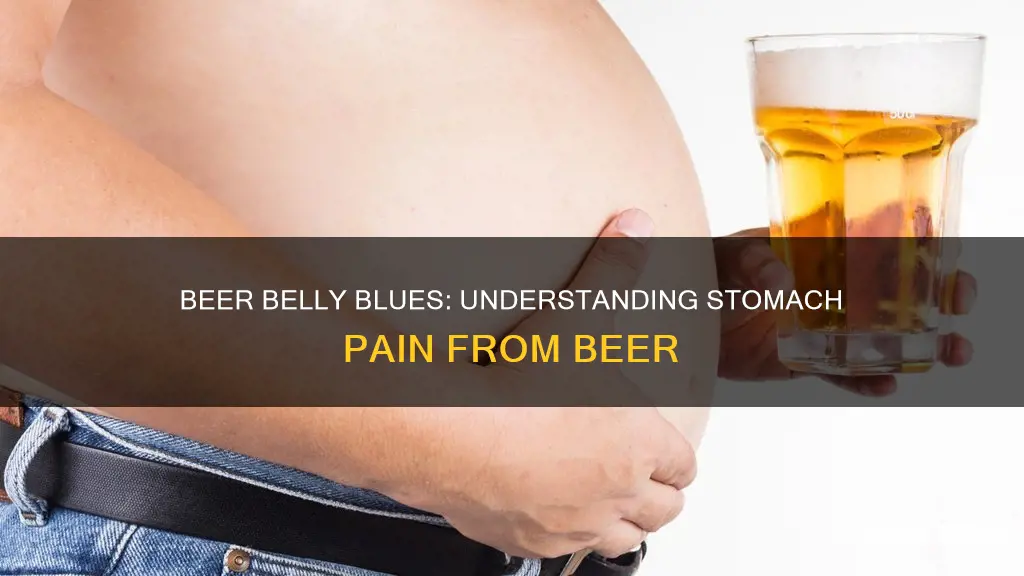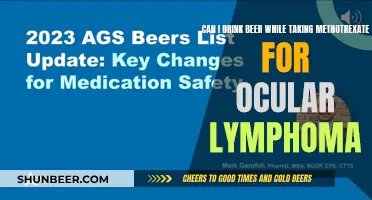
Beer is a popular alcoholic beverage, but for some, it can cause stomach pain and discomfort. While moderate consumption may not affect most people, beer has the potential to irritate the stomach and trigger or worsen pre-existing conditions. Understanding the causes of stomach pain from drinking beer can help individuals make informed decisions about their beverage choices and seek appropriate medical advice if needed. In this article, we will explore the various reasons why beer may lead to stomach pain and provide insights into managing this unpleasant side effect.
What You'll Learn

Beer allergy
Beer allergies are rare, and you may have an intolerance to beer or an allergy to one of its ingredients. However, it's important to get a proper diagnosis to determine if you have a true beer allergy.
Symptoms of a Beer Allergy
If you're allergic to beer, you will likely experience symptoms similar to other allergic reactions, such as abdominal pain and bloating, and tightness of the chest. An allergic reaction to beer usually happens within a couple of hours. However, allergic reactions involving hives, wheezing, and chest pain may occur almost immediately and are considered severe and potentially life-threatening. If you experience these symptoms, seek immediate medical attention.
Causes of a Beer Allergy
Beer contains many ingredients that may cause an allergic reaction. The most common cause of beer allergies is sensitivity to sorghum or sorghum malt. Other ingredients that may cause an allergic reaction include:
- Malted barley or other grains, such as wheat and gluten
- Brewer's yeast
- Hops or other flavourings
- Histamines
- Sulfites
- Assorted colourings, flavourings, and preservatives
Diagnosis and Treatment of a Beer Allergy
The best way to determine if you have a beer allergy is to visit an allergist for specific allergy tests. One of the easiest ways to diagnose allergies is through a skin prick test, which takes about 15 minutes. If a skin prick test cannot be used, other methods such as an elimination diet or provocation test may be employed.
If you are allergic to beer, the best treatment is avoidance. It's important to stay away from the specific ingredients you are allergic to. A gluten-free diet, for example, may be necessary if you are allergic to gluten or barley.
The Beer Choice of Gibbs
You may want to see also

Acid reflux
Drinking beer or other alcoholic beverages can trigger acid reflux, a condition where stomach acids flow back up into the oesophagus, causing a painful, burning sensation known as heartburn. This occurs when there is a malfunction in the lower oesophageal sphincter (LES), which is supposed to keep stomach acids from flowing back up into the oesophagus. When the LES malfunctions, stomach acid can escape upward, damaging the oesophageal lining and causing irritation and pain.
Beer and other alcoholic drinks can aggravate acid reflux in several ways. Firstly, alcohol increases the production of stomach acid. According to a study published in the March 1999 issue of "The Journal of Clinical Investigation," alcohol and the maleic and succinic acid found in beer increase stomach acid secretion. This excess acid can then travel up into the oesophagus, causing irritation and pain. Additionally, carbonation in beer can lead to bloating and belching, which also increases the likelihood of acid entering the oesophagus. Furthermore, alcohol slows down stomach emptying, making regurgitation of stomach contents more likely.
Research has shown a link between alcohol consumption and the development of gastroesophageal reflux disease (GERD), a more severe and chronic form of acid reflux. Higher intake and frequency of alcohol consumption are more strongly associated with GERD. However, the relationship between alcohol and GERD is complex and not yet fully understood, with some studies finding conflicting results. For instance, a 2022 review found that drinking three or fewer alcoholic beverages a week may be associated with GERD, while a Swedish study found no association between alcohol consumption and GERD.
To minimise the risk of acid reflux, it is recommended to avoid drinking alcohol altogether or to drink in moderation. Other tips include staying hydrated, avoiding drinking acidic or carbonated beverages, and eating small meals early in the evening. Distilled spirits like vodka and whiskey may be better choices for those prone to acid reflux as they are low in calories, carbs, and sugar and have a higher ethanol content, which is less likely to stimulate stomach acid secretion.
Beer and Gastritis: Is There a Link?
You may want to see also

Gastritis
Drinking beer or other alcoholic beverages can irritate the stomach and digestive system. Alcohol can increase the amount of acid in the stomach, which can irritate and erode the stomach lining, causing inflammation and pain. This condition is known as gastritis.
The symptoms of gastritis can vary in intensity and duration. Acute gastritis can cause sudden and severe symptoms, while chronic gastritis may result in long-lasting discomfort. Common symptoms include a gnawing or burning stomach ache, a constant pain between the navel and ribs, belching and hiccuping, and a bloated or uncomfortably full feeling in the stomach after eating. Other possible symptoms include nausea, vomiting, and indigestion. In some cases, gastritis may not cause any noticeable symptoms.
If you experience mild or occasional stomach pain after drinking beer, reducing your alcohol consumption is recommended. If even small amounts of beer trigger discomfort, it is advisable to avoid beer or consult a doctor for strategies to manage the pain. For more severe or persistent pain, it is essential to seek medical advice.
Beer Alternatives for Weight Loss: What to Drink Instead?
You may want to see also

Liver disease
Alcohol-related liver disease (ARLD) is caused by drinking more alcohol than the liver can process, which damages the organ. The liver is responsible for performing many functions in the body, including filtering toxins from the blood, aiding digestion, and regulating blood sugar and cholesterol levels. When the liver breaks down alcohol, the chemical reaction releases toxins that damage liver cells.
ARLD has several stages of severity and a range of associated symptoms. The early stages of ARLD may not cause any noticeable symptoms, but one of the sure signs of liver disease is pain in the liver after drinking alcohol. Normally, liver pain is felt on the right side of the abdomen, but it can also occur in the front centre of the belly or just under the lower right ribs. The pain can be throbbing or stabbing and may come and go.
There are three main types of ARLD:
- Alcoholic fatty liver disease: This is the first stage of ARLD and is caused by a build-up of fats in the liver due to drinking a large amount of alcohol, even for just a few days. Fatty liver disease rarely causes symptoms, but it is a warning sign that a person is drinking at a harmful level. This stage is reversible if the person stops drinking alcohol for at least two weeks.
- Alcoholic hepatitis: This condition is marked by inflammation, swelling, and the killing of liver cells, which scars the liver. Symptoms may occur over time or suddenly after binge drinking. They include fever, jaundice, nausea, vomiting, abdominal pain, and tenderness. Alcoholic hepatitis can be mild or severe, and in some cases, it can be life-threatening. Mild cases can be reversed by stopping alcohol consumption.
- Alcohol-related cirrhosis: This is the most serious form of ARLD, where the entire liver is scarred, causing the organ to shrink and harden, which can lead to liver failure. At this stage, the damage is usually irreversible. Even with treatment, a person with alcohol-related cirrhosis who doesn't stop drinking has a less than 50% chance of living for at least five more years.
The best way to prevent ARLD is to stop drinking alcohol or stick to low-risk drinking guidelines. Abstinence is critical following an ARLD diagnosis, and even one drink is too many. Alcohol avoidance is the only way to possibly reverse the damage or prevent the disease from worsening. In addition to abstinence, lifestyle changes such as eating healthy foods, exercising, and maintaining a healthy weight can also help treat liver pain.
Beer Drinking at Brimfield Fair: What's Allowed?
You may want to see also

Pancreatitis
Drinking beer or other alcoholic beverages can cause abdominal pain and discomfort. While moderate consumption usually does not cause issues, excessive alcohol intake can lead to severe medical consequences, including pancreatitis.
There are two types of pancreatitis: acute and chronic. Acute pancreatitis involves a sudden onset of symptoms, ranging from mild to life-threatening, such as nausea and pain in the upper abdomen or back. Severe cases may lead to major complications, including organ failure and infections. Chronic pancreatitis, on the other hand, is a long-standing disease characterised by scarring and irreversible destruction of pancreatic tissue.
Alcohol and Pancreatitis
Alcohol is a significant cause of pancreatitis, especially in chronic cases. While alcohol is not the only cause of pancreatitis, heavy drinking can lead to both acute and chronic forms of the disease. Alcohol abuse is typically the cause of chronic pancreatitis.
The exact mechanism by which alcohol causes acute pancreatitis is not yet fully understood. One theory suggests that alcohol molecules interfere with the cells of the pancreas, disrupting their normal functioning. Additionally, alcohol increases the amount of acid in the stomach, which can irritate and inflame the stomach lining, leading to a condition called gastritis. This, in turn, can increase the risk of developing stomach ulcers.
Heavy drinking and acute pancreatitis can lead to repeated episodes of inflammation, causing permanent damage to the pancreas and resulting in chronic pancreatitis. Continuing to consume alcohol after recovering from acute pancreatitis increases the likelihood of future episodes and exacerbates the condition.
Chronic pancreatitis is a long-term condition where the pancreas remains inflamed and painful for years, impairing its ability to function properly. Heavy drinking is the most critical risk factor for chronic pancreatitis, responsible for 70-80% of cases in western Europe. Regularly drinking above the recommended guidelines increases the risk of developing this condition.
Prevention and Treatment
To reduce the risk of developing pancreatitis, it is essential to limit alcohol consumption within the Chief Medical Officers' low-risk drinking guidelines. These guidelines recommend consuming no more than 14 units of alcohol per week, spread over several days with drink-free days included, and avoiding binge drinking.
If diagnosed with acute pancreatitis, it is crucial to stop drinking alcohol completely and adopt a low-fat diet to prevent further attacks and the development of chronic pancreatitis. For those with chronic pancreatitis, abstaining from alcohol is imperative to prevent further alcohol-related damage to the pancreas. Even "alcohol-free" drinks should be avoided, as they may contain small amounts of alcohol.
Drinking Beer in an Uber: Is it Allowed?
You may want to see also
Frequently asked questions
Beer contains alcohol, which irritates the stomach lining and increases acid production. This can lead to acid reflux, where acid escapes from the stomach into the oesophagus, causing irritation and a painful burning sensation. Beer is also carbonated, which can lead to bloating and belching, making it even easier for stomach acid to travel up into the oesophagus.
Gastritis is inflammation of the stomach lining, which can be caused by drinking too much alcohol. Symptoms of gastritis include a gnawing or burning ache in the stomach, a constant pain between the navel and ribs, belching and hiccuping, and a bloated or full feeling in the stomach.
The only way to completely avoid stomach aches from drinking beer is to stop drinking it. However, if you want to continue drinking beer, you can try to minimise the pain by eating plain carbohydrates, staying hydrated, and taking antacids or supplements like ginger and peppermint to reduce nausea.







